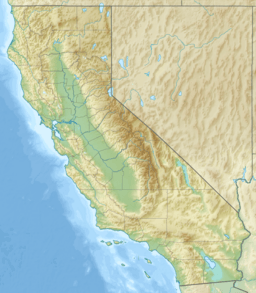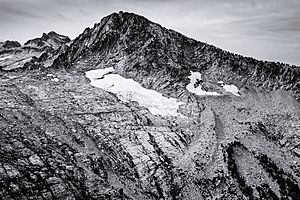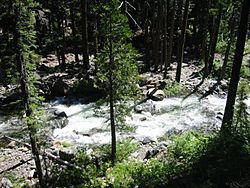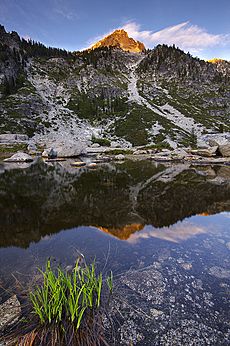Trinity Alps facts for kids
Quick facts for kids Trinity Alps |
|
|---|---|
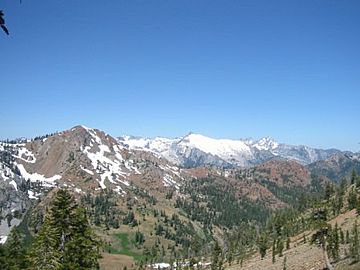
Trinity Alps near Granite Lake
|
|
| Highest point | |
| Elevation | 2,744 m (9,003 ft) |
| Geography | |
| Country | United States |
| State | California |
| Region | Shasta Cascade |
| District | Trinity County |
| Range coordinates | 41°0′1.505″N 123°2′54.126″W / 41.00041806°N 123.04836833°W |
| Topo map | USGS Thompson Peak |
The Trinity Alps are a beautiful mountain range in Northern California. They are found in Siskiyou and Trinity counties. These mountains are part of the larger Klamath Mountains and are located north of the town of Weaverville.
Contents
Exploring the Trinity Alps: Geography
The Trinity Alps are part of a big natural area called the Pacific Coast Ranges. They are in the Klamath Mountains System. This system sits between the California Coast Ranges to the west and the Cascade Range to the east. The mountains here range in height from about 411 meters (1,350 feet) to 2,744 meters (9,001 feet) at Thompson Peak. Other tall peaks include Granite Peak and Ycatapom Peak.
People love the Trinity Alps for their amazing views and high-mountain scenery. The plants that grow here are special and different from those found in the Sierra Nevada or the Cascades. Nearby mountain ranges include the Salmon Mountains and Scott Mountains.
The Trinity Alps Wilderness is a huge protected area. It covers about 2,092 square kilometers (517,000 acres). This makes it the second largest wilderness area in all of California.
Ice and Snow in the Mountains
Even in California's warm climate, the Trinity Alps have snow and ice that last all year. The lowest snowfield that usually doesn't melt away is above Mirror Lake. It sits at an elevation of about 2,012 meters (6,600 feet).
The only real glacier in the area is the Grizzly Glacier. It's a 6-hectare (15-acre) icefield on the north side of Thompson Peak. This glacier has deep cracks called crevasses, which show it's actually moving, even though it's small.
Scientists have found that some glaciers in the Trinity Alps are better at resisting the effects of global warming than other glaciers in California. Maps show that there are 35 permanent areas of snow and several tiny glaciers on the highest peaks.
Temporary Glaciers
Sometimes, a special thing happens on the ridge south of Sapphire Lake. After years of heavy snowfall, a temporary glacier can form here. This ice body can even have active crevasses and tall ice towers. However, because this area gets a long, hot, dry season, this temporary glacier can completely disappear during drier years.
Studies of tiny plant-like growths called lichen show that the area near Kalmia Lake gets a lot of snow. It might even be the snowiest spot in California! This helps explain why there's an active glacier under Thompson Peak.
Nature in the Trinity Alps
Plants and Trees: Flora
The Trinity Alps are amazing for plants, especially conifers (trees with cones like pines). This area has the second highest number of conifer species in the entire world! Why so many? The Trinity Alps are where the Mediterranean climate from the south meets the cooler, wetter Northwestern coastal climate. This mix creates a perfect home for many different types of trees.
You can find trees from northern areas here, like subalpine fir (Abies lasiocarpa), Pacific silver fir (Abies amabilis), and Engelmann spruce (Picea engelmannii). You'll also see southern trees, such as incense cedar (Calocedrus decurrens), ponderosa pine (Pinus ponderosa), and white fir (Abies concolor). Plus, there are unique populations of foxtail pine (Pinus balfouriana) and weeping spruce (Picea breweriana).
Other interesting plants you might see on the trails include the meat-eating California pitcher plant. There's also the pretty pinkish Lewisia cotyledon and a rare wildflower called Trinity penstemon (Penstemon tracyi), which only grows in the Trinity Alps.
Large fires have burned through some of the forests in the wilderness. For example, a big fire complex in 2008 burned over 428 square kilometers (105,855 acres).
Animals: Fauna
Most of the lakes in the Trinity Alps have been stocked with fish like rainbow, brown, or brook trout. Some of these fish populations can now grow and reproduce on their own. The main streams of the North Fork Trinity River and New River have chinook salmon that come to lay their eggs. Some streams also have steelhead.
The Trinity Alps are home to lots of wildlife, including:
- American black bears
- Mountain lions
- Bobcats
- Blacktailed deer
- Lizards
- Chipmunks
- Many different bird species
Deer and black bears are often seen. Animals that are harder to spot but still live here include mountain lions, pine martens, fishers, and wolverines. You might also find Rough-skinned newts in ponds and lakes. There's even a local legend about a very large salamander, sometimes called the Trinity Alps Giant Salamander!
Rocks and Land: Geology
The Trinity Alps are made up of different kinds of rocks. You'll find igneous rocks (formed from cooled lava), granite (a type of igneous rock), and metamorphic rocks (rocks changed by heat and pressure).
The mountains are often described by their colors:
- The eastern mountains are called the Red Trinities because of reddish rocks like peridotite.
- The central mountains are the White Trinities due to their granite rocks.
- The western mountains are the Green Trinities because they have more trees covering them.
The region has many pine and fir forests, along with meadows, creeks, and lakes.
Fun Activities: Recreation
Most of the Trinity Alps Wilderness is managed by the US Forest Service through the Shasta-Trinity National Forest. Parts of the wilderness also extend into the Klamath National Forest and the Six Rivers National Forest.
The wilderness is a great place for:
- Hiking on many trails
- Backcountry camping (camping away from developed campgrounds)
- Enjoying beautiful scenery
You can get to the Trinity Alps from California State Route 299 in the south and CA Route 3 in the east. There are also old logging and mining roads on the north and west sides. If you plan to hike or camp, you will need a wilderness permit. The Pacific Crest Trail connects the northeast part of the Trinity Alps to other wilderness areas.
Some areas are visited less often, like New River and Salmon Mountain. Other parts, like Canyon Creek Lakes and Emerald Lake, are very popular. The western ridges are usually lower and can be hot and dry in the summer. Not all lakes have trails leading to them, so sometimes you might need to hike off-trail.
The Trinity Alps overlook Trinity Lake to the east. This is a large reservoir on the Trinity River. People also come here for hunting deer, bears, and birds during hunting season. If you like rock climbing, there are excellent granite cliffs in areas like Caribou Peak.
Images for kids


